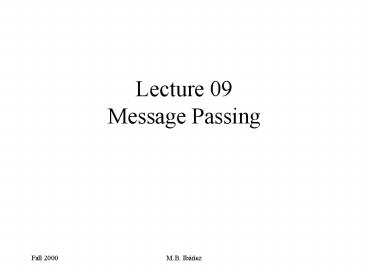Lecture 09 Message Passing - PowerPoint PPT Presentation
1 / 11
Title:
Lecture 09 Message Passing
Description:
The send primitive includes a specific identifier of the destination process. send(P,message) ... explicitly designate a sending process. receive(Q,message) ... – PowerPoint PPT presentation
Number of Views:54
Avg rating:3.0/5.0
Title: Lecture 09 Message Passing
1
Lecture 09Message Passing
2
Requirements to be satisfied
- Synchronization
- Process need to be synchronized to enforce mutual
exclusion - Communication
- Cooperating processes may need to exchange
information - Solutions
- Shared memory communication scheme
- Message passing communication scheme
3
Operations Needed
- send(destination, message)
- A process send information in the form of a
message to another process designated by a
destination - receive(source, message)
- A process receives information by executing the
receive primitive, indicating the source of the
sending process and the message
4
Message Size
- Fixed size
- Physical implementation straightforward
- Difficult programming
- Variable size
- More complex physical implementation
- The programming task becomes simpler
5
Message Buffering
- When a process sends a message to another
process, is it copied into the receivers memory
or in a buffer in between? - No buffer
- The processes must be synchronized for a message
transfer to take place (rendezvous) - Bounded buffer
- The buffer has finite length N thus, at most N
messages can reside in it - Unbounded buffer
- Any number of messages can wait in the buffer.
The sender is never delayed.
6
Synchronization
7
Direct Addressing
- The send primitive includes a specific identifier
of the destination process - send(P,message)
- The receive primitive
- The process explicitly designate a sending
process - receive(Q,message)
- Receive a message from any process
- receive(id-variable,message)
8
Indirect Addressing
- The relationship between senders and receivers
can be - one to one
- many to one (useful for client/server
interaction, the mailbox is referred as a port) - one to many (useful for applications where a
message is to be broadcast to a set of processes) - many to many
9
Bounded-buffer producer/consumer problem I
- const
- capacity / buffering capacity /
- null / empty message /
- var i integer
- ...
- create_mailbox(mayproduce)
- create_mailbox(mayconsume)
- for i 1 to capacity do send(mayproduce,null)
- parbegin producer consumer parend
10
Bounded-buffer producer/consumer problem II
- procedure producer
- var pmsg message
- while true do
- receive(mayproduce,pmsg)
- pmsg produce
- send(mayconsume,pmsg)
11
Bounded-buffer producer/consumer problem III
- procedure consumer
- var cmsg message
- while true do
- receive(mayproduce,cmsg)
- consume(cmsg)
- send(mayconsume,null)































